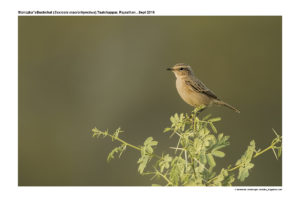Stolickza Bushchat

Stolickza Bushchat Saxicola macrorhynchus
Etymology:
- Saxicola : Latin word saxum – stone; cola- dweller { Stone dweller}
- Macrorhynchus : Greek word Makros- Long, Great ; Rhyncus – Bill, Beak { Great Beaked}
Distribution in India: Resident in state of Rajasthan (Taal Chappar is a good place to see it)
Description: Size of 15-17 cm. Slim, Long tail and Long, thin beak. Male has white supercilium, white patch on inner wing coverts, whitish under parts with buff wash to breast and white on tail. Upper parts and ear coverts are black in Breeding and streaked and brown in Non-breeding. The female is like male non breeding but paler and lacks white on wings or tail. The juvenile is like female, but darker above and dark-dappled on breast.
Habitat: It is found Dry sandy semi-desert and desert plains with low herb layer and shrubs and very scattered bushes. In winter found in short clumps of coarse grass within areas of very short grass or bare sandy substrate, and with a few thorn trees
Food Habits: It eats Insects, including flies and their larvae, ants, wasps and beetles; also plant material. Forages from low open perch such as bush top or grass stem, flying to ground to take food item or sallying in air. Often remains on ground, hopping, for several minutes at a time, rather than returning to perch. Foraging commonest in middle of day and in evening, when flying insects most abundant. In colder conditions, most foraging is terrestrial.
Breeding Habits: They breed in March- June. Nothing much is known about their breeding/ nesting pattern.While feeding, the bird suddenly puffs up its belly and shakes side-ways, relaxes and resumes its activity. It does this periodically. No-one knows for sure what this means, and there are several hypotheses. It is a courtship ritual, while others feel it could be a threat display; yet others feel this could be a tactic to flush out insects. The latter explanation seems more in-line with chat family behaviour. Whatever it is, there is a need to study and probe this interesting and unique behaviour.